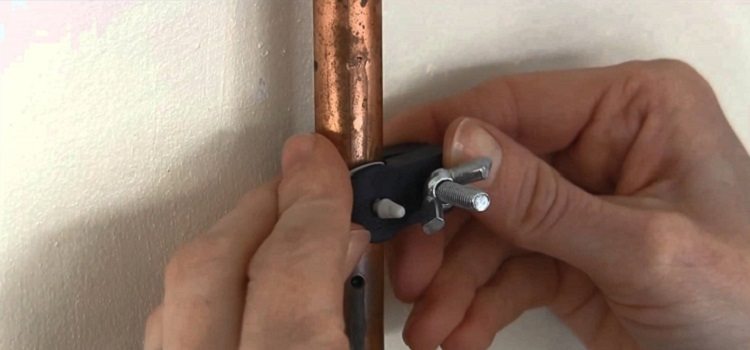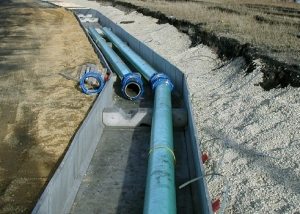Any water pipes are subject to wear. This also applies to budget plastic constructions (HDPE), and pipes made of more expensive materials: copper or metal plastic. The need for repairs may arise due to poor quality mounting or non-compliance with the technical standards during installation. One way or another, repair of existing structures is a much more profitable option than a complete replacement of the water supply system.
Content
DIY repair rules for plastic pipes
Despite the high wear resistance of plastic pipes, leaks in such a plumbing system are not uncommon. Basically, repair is required when the pipe connection was poorly performed: for example, when tightening the nut fitting. Doing repair of metal-plastic structures with your own hands is quite realistic, you just need to find a solution to the task:
- Elimination of leaks in connections with compression fittings. One of the common problems in a system of plastic pipes may be due to insufficient tightening of the nut. If tightening it with a key does not help, shut off the water supply and inspect the damaged area. Perhaps the breakdown was caused by damage to the o-ring located between the body of the fitting and the fitting. Also, attention should be paid to the condition of the fitting gasket. The part that caused the leak must be replaced. After completion of work, the joints are lubricated with silicone sealant.
- Repair of cracks in plastic pipes. The cracked pipe section is in most cases to be replaced. But sometimes, when the crack is small, a bandage may be applied to it. Bandages are only temporary, installed before the replacement of the emergency site. The crack site is covered with soft rubber material and secured with a metal clamp.
- Elimination of leakage in the joints of metal-plastic pipes with press fittings. This connection is non-separable, so part of the pipe is cut off along with the fitting, the place of cut is cleaned with fine-grained emery paper. A new fitting is put on the prepared end of the pipe, the connection is crimped again. Such a malfunction of metal-plastic pipe fittings can be repaired by itself if a crimping tool is available (for example, special pliers).

The procedure for replacing the crimp fitting includes the same steps as for the initial installation of the connecting elements
Helpful advice! Very small cracks in plastic pipes are repaired by cold welding. The pipe section is degreased, cleaned and processed with a special compound, which can be purchased at any hardware store. You can use the repaired pipe in a day.
Metal pipe repair requirements
Natural wear of metal pipes often leads to the need for urgent repairs. Measures to troubleshoot the operation of copper, steel or cast iron pipes are also easy to do with your own hands.
Repairing copper water pipes often requires fixing the problem caused by metal stratification.In this case, apply high temperature soldering using brazing alloy. This solution allows you to extend the operational life of the pipe. Also, the owners of water pipes from copper pipes often encounter cracks in the places of the bend of the structure. To repair this type of damage, especially if their area is small, low-temperature welding with soft solder is used.
Helpful advice! In order to avoid cracks in the bends, it is worth remembering the rules for installing copper pipes. A bending radius of more than 3.5 pipe diameters is not allowed for diameters below 1.5 cm.
As with the soldering of any other types of pipes, copper products need preliminary cleaning from grease and contaminants. Otherwise, the repair will not give effect and will not solve the current problem.
Copper pipe repair may also be required in case of failure fittingconnecting the two sections of the water supply. If the nut or gasket is out of order, you can get by replacing only this small part. If the fitting, fixed by soldering, has leaked, you will have to cut out part of the pipe and solder a new segment with a new coupling.
Pipes made of durable materials such as cast iron or steel also do not guarantee that there is no need for repairs. In order to temporarily close a small crack before repairing the cast-iron pipes of the water supply and sewage systems, a rubber pad can be used. Even a part of the car camera or tire will do. The lining is fixed on cast iron and steel pipes with metal clamps.
For sealing damage in a cast iron pipe of an insignificant nature they use a rather old, but current method of eliminating a leak with their own hands: it consists in using a bandage soaked in cement mortar. A strip of bandage is wrapped several times around the pipe. Since the cement mortar hardens for a long time, the pipeline must be closed at least for a day.
In case of extensive damage, cast-iron pipes must be replaced. The use of special sealants and compositions such as "cold welding" is not excluded. Such tools are also suitable for repairing steel pipes.
DIY plastic pipe repair features
Plastic pipe repair, namely polyethylene (HDPE) or polypropylene, carried out by simpler methods than the repair of metal structures. Damaged areas can be connected by conventional welding for such pipes at home. Any work on the repair of polyethylene HDPE or LDPE pipes begins with the diagnosis of problem areas. There are several types of defects and problems that are caused by violations of the installation of plastic pipes.
Leak in polyethylene pipes. There can be several options for solving this problem, depending on the cause of the leak and the amount of damage:
- if the problem is insufficient sealing of the fitting, then to eliminate the problem, shut off the water and tighten the nut in it. One of the probable reasons for this phenomenon can be called not completely blocked water when welding polyethylene pipes with a fitting, if the work was carried out under pressure. Leaks in the joints of polyethylene pipes can also be secondary, which appeared after an unsuccessful repair. In this case, the damaged fitting is replaced with a new one;
- if water leaks from a cracked pipe, but the damage area is small, then the problem can be eliminated by simply gluing polyethylene pipes. The patch is made of fiberglass or plastic. The material is wetted with epoxy glue, then wound around the HDPE pipe 5-6 times.The bandage is tightly pressed to the problem area with a screed or clamp and is left for better connection with the HDPE pipe for a day.
The appearance of cones on the pipe. This problem can lead to pipe rupture in the place of swelling in the future, therefore, it is advisable to repair immediately after the deformation is detected. Crimping a pipe with a clamp does not bring the desired results, so the procedure for repairing HDPE pipes (and other pipes made of polymers) with your own hands will be as follows:
- shutdown of the water supply system;
- measuring the area of the replaced pipe. In this case, the stock is taken into account - 3 cm on each side;
- using a pipe cutter or a sharp hacksaw, a section of the damaged pipe is cut and a new segment is prepared;
- the ends of the polyethylene pipes from which the section was cut should be wiped with a dry cloth;
- soldering of new sections of the water supply using a soldering tool.
Swelling of plastic pipes (when a large section of the system greatly increases in volume). This kind of pipe defects is most often observed in hot water systems. Such problems arise due to the fact that the pipe was chosen incorrectly and is not able to withstand high temperatures. In such cases, urgent replacement of the entire pipeline with denser pipes is required.
Pipe crushing. In most cases, such a defect does not require urgent repair measures. If in the whole system one plastic pipe was deformed, this may not affect the performance of the water supply system in any way. The deformation of polyethylene (HDPE) systems could be caused by mechanical factors (impact on the pipe, for example), and the pipe itself may even out under the influence of internal pressure. If this does not happen and collapse affects the pipe passability, the damaged area should be replaced.
Helpful advice! Scratches and cracks on the surface of polypropylene pipes and HDPE pipes, the depth of which is more than 10% of the total wall thickness, are also indications for the replacement of the section.
All of the above methods do not represent technical complexity, and are also very relevant if urgent repair of drainpipes with your own hands is required. An exception is considered to be complex malfunctions of a plastic or metal drain structure, when the repair of drainpipes will include the replacement of elements at a high level from the ground. In such cases, the best solution would be to contact a team of specialists.









